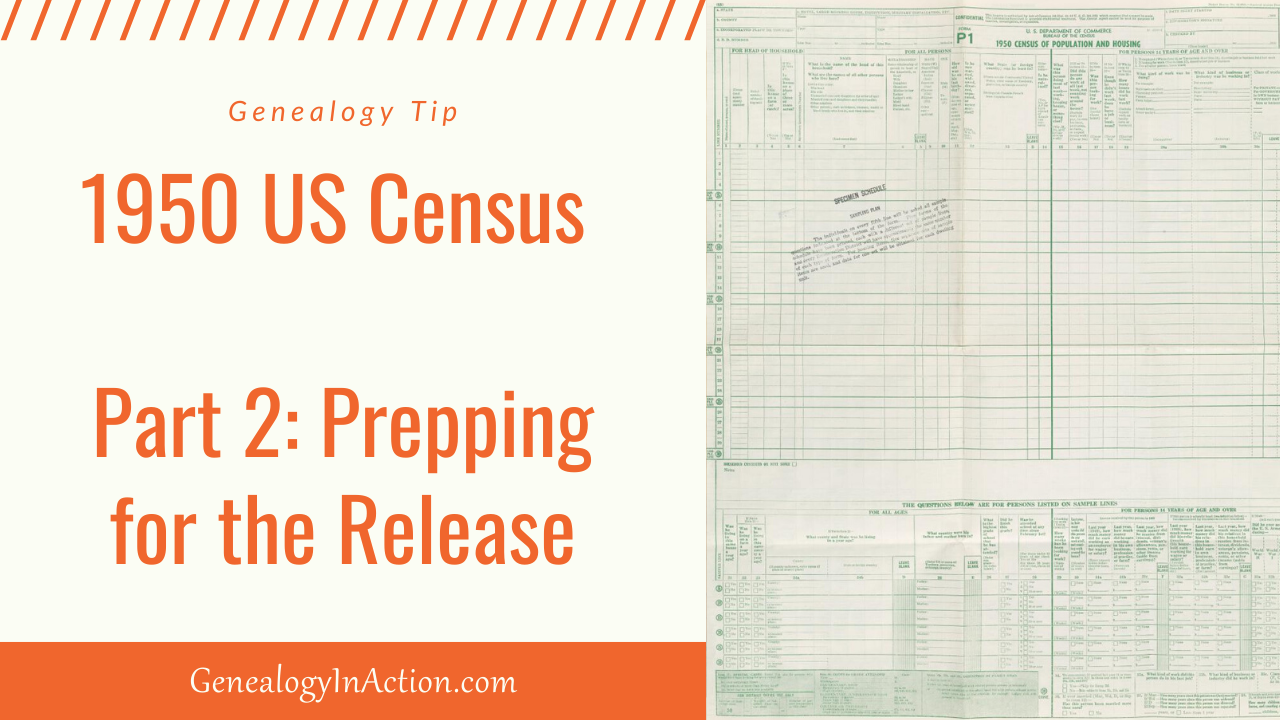
1950 US Census Part 2: Prepping for the Release
Feb 24, 2022This post contains an affiliate link. You can review my full Disclaimer here.
The release of the 1950 US census is right around the corner on April 1, 2022, so you might be wondering how you can be ready to start searching on Day 1. In this post I’ll walk you through my process so you can use it or adapt it for your own preparation.
Before we dive in, you might be wondering why I’m prepping for the census release. First, I want to know who in my database may be in the 1950 census, because I believe you should always try to find every census for a person. I’m also going to look up enumeration districts for my “important” people because I don’t want to rely on the handwriting OCR technology that will be used by NARA to allow name searching on Day 1. I’d rather be pleasantly surprised than unprepared. And honestly, I think it’s fun to do things the “old school” way every once in awhile.
High-Level Overview of Process
I’m using Legacy Family Tree to run my searches, but I will share some tips at the end of this post if you’re using another genealogy database program or an online family tree. Here are the step I followed:
- Run a the Census List search for everyone in my database that is likely to appear in the 1950 US census.
- Tag them with a “1950 Census Search List” tag (this way I know from their profile that I need to find the 1950 census for them, which I can get to whenever there’s a better index to work with; I’ll untag them when I’ve found them in the census).
- Run a custom focus group search that is set up to pull my direct line and their immediate family members (on Day 1 I’ll only be concerned with these people, otherwise, I’d have more than 2,800 people to look for in the 1950 census!).
- Run the Census List search again, but choose “only search the Search List” so that I can narrow down my list from the focus group search to only those that are likely to appear in the 1950 census.
- Export the data to a comma-separated values (.csv) file.
- Open the CSV file in Excel (you can use Google Sheets too).
- Save the file in the Excel spreadsheet file format (.xls or .xlsx).
- Format the spreadsheet as needed.
- Add columns for location/address on either side of 1950 (”Last Known Prior to April 1, 1950” and “Next Known After April 1, 1950”)
- Add an “ED” column before each of the above locations/addresses columns to collect the enumeration districts.
- Use the Unified 1880-1950 Census ED Finder to look up ED and record it in spreadsheet.
This is the file I will be working with on Day 1 to find my “important” people.
Demonstration of Process
Check out this video to see a behind-the-scenes, step-by-step demonstration of my process in real time.
Tips for Other Genealogy Programs & Online Trees
If you’re using another genealogy database program, like RootsMagic or Family Tree Maker, check to see if there is a pre-made census search report or something similar. Otherwise, you’ll have to use a custom report using conditions such as:
- born before April 1, 1950
- died after April 1, 1950 or no death date is blank
- a residence event contains United States
- etc.
If you only store your tree on a genealogy website, such as Ancestry or MyHeritage, you’ll have to export a GEDCOM file to work with the data. The GEDCOM file can be imported into a genealogy database program like Legacy or RootsMagic, at which point you could run a search report. Otherwise, you’ll have to use a program to convert the GEDCOM file into a comma-separated values file (.csv) to bring it into Excel or Google Sheets. From there, you can manually filter and sort the data to get to a list of people that may appear in the 1950 census. To find a converter program, simply search for GEDCOM to CSV in your favorite search engine or head to Cyndi’s List for several options to choose from in the GEDCOM Software & Tools section.

Now that you’ve seen my process, it’s your turn to generate your list of people that should appear in the 1950 census so you can systematically work through each person. If you plan to do some searches on Day 1, such as for yourself, your parents, grandparents, or other “must-find-right-away” people, I strongly suggest looking up enumeration districts just in case the index doesn’t help in your search. Remember, the index will not be perfect, so having the location and ED number may be the only way to find individuals right away.
I hope you enjoyed this article and that you’re ready to prep for the 1950 US census release. If you found this article helpful, be sure to add the Genealogy In Action blog to your favorite RSS reader.
